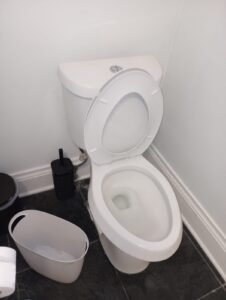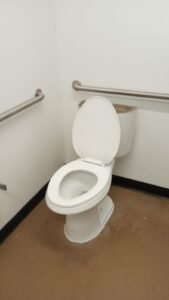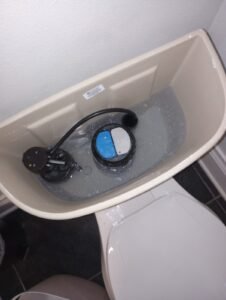7 Top Toilet Fixes Every Homeowner Should Know
Every homeowner knows that toilet troubles are not just a minor inconvenience but can escalate into major household disruptions if not addressed promptly. Understanding the most common toilet issues and how to fix them is essential for maintaining a comfortable and functional home. This comprehensive guide will delve into seven top toilet problems, offering practical solutions and tips to keep your bathroom in top shape.
1. Clogged Toilet
A clogged toilet is a common and often distressing problem in households. Understanding the causes, how to fix it yourself, and how to prevent future clogs can save you time, money, and inconvenience.
Causes of a Clogged Toilet
- Excessive Toilet Paper: Using too much toilet paper can easily clog pipes, especially in older plumbing systems.
- Non-Flushable Items: Flushing items such as wipes (even those labeled flushable), feminine hygiene products, cotton balls, and diapers.
- Foreign Objects: Children’s toys, bottles, or any other foreign objects accidentally or intentionally flushed down.
- Tree Roots: Infiltration of tree roots into sewer lines can cause recurring clogs, particularly in older homes.
- Pipe Issues: Old or damaged pipes may have rough surfaces or obstructions that catch waste and toilet paper.
- Low-Flow Toilets: Older low-flow toilets may not provide enough pressure to clear the pipes effectively.
DIY Fixes for a Clogged Toilet
- Use a Plunger: The first line of defense. Ensure you have a good seal around the opening and plunge vigorously to dislodge the clog.
- Toilet Auger: A more advanced tool than a plunger, a toilet auger can reach deeper into the toilet to break up clogs.
- Hot Water and Dish Soap: Pour a mixture of hot water and dish soap into the bowl. The soap can help lubricate the clog, and the hot water can help break it down.
- Baking Soda and Vinegar: Pour one cup of baking soda followed by one cup of vinegar into the toilet. This can create a chemical reaction that can help dissolve the clog.
- Wire Hanger: Straighten a wire hanger and use it to gently poke through the clog. Be careful not to scratch the toilet bowl.
Precautions to Prevent Future Clogs
- Use Less Toilet Paper: Educate your household about using a reasonable amount of toilet paper.
- Dispose of Non-Flushable Items Properly: Place a trash bin in the bathroom for disposing of items that shouldn’t be flushed.
- Regular Maintenance: Regularly clean your toilet and check for early signs of clogging.
- Childproof Your Toilet: If you have young children, consider installing a childproof lock on the toilet seat to prevent them from flushing foreign objects.
- Inspect Your Plumbing: If you have frequent clogs, have a professional inspect your plumbing system for any underlying issues.
- Avoid Chemical Drain Cleaners: These can damage your plumbing over time. Stick to mechanical methods like plunging or augering.
- Educate Your Household: Make sure everyone in your home knows what can and cannot be flushed.
- Regularly Check for Tree Root Growth: Especially important in older homes, have a professional check for tree root intrusion in your sewer lines.
- Upgrade Your Toilet: If you have an older low-flow toilet and experience frequent clogs, consider upgrading to a newer, more efficient model.

2. Running Toilet
A toilet that won’t run or flush is a less common but equally frustrating problem than a clogged toilet. Understanding why a toilet isn’t running and how to fix it is crucial for maintaining the functionality of your bathroom.
Common Causes of a Not Running Toilet
- Water Supply Issues: If there’s no water in the tank, your toilet won’t run. This could be due to a turned-off water supply valve or a problem with your home’s water supply.
- Faulty Fill Valve: The fill valve controls the water flow into the toilet tank. If it’s malfunctioning or broken, water won’t fill the tank.
- Disconnected or Broken Lift Chain: The lift chain connects the flush lever to the flapper. If it’s disconnected or broken, flushing the toilet won’t lift the flapper to release water.
- Damaged Flapper: A damaged or warped flapper can prevent water from entering the bowl from the tank.
- Blocked Inlet Holes: If the inlet holes under the rim of the toilet bowl are blocked, water can’t flow into the bowl, preventing a flush.
DIY Fixes
- Check the Water Supply Valve: Ensure that the valve, typically located behind the toilet, is fully open. If it’s closed, turn it counterclockwise to open it.
- Inspect and Replace the Fill Valve: If the fill valve is faulty, it may need to be adjusted or replaced. This involves turning off the water supply, draining the tank, and installing a new valve.
- Reconnect or Replace the Lift Chain: If the chain is disconnected, reattach it to the lever and flapper. If it’s broken, a replacement can be easily installed.
- Replace the Flapper: A damaged flapper should be replaced. Turn off the water supply, flush the toilet to drain the tank, and install a new flapper.
- Clean the Inlet Holes: Use a small piece of wire or a plumbing tool to clean out any debris blocking the inlet holes.
Precautions to Prevent Future Issues
- Regular Maintenance: Regularly inspect the internal components of your toilet, including the fill valve, flapper, and lift chain.
- Avoid Harsh Chemicals: Harsh chemicals can damage the components inside the toilet tank. Use mild cleaners for maintenance.
- Monitor Water Pressure: Sudden changes in water pressure can affect your toilet’s functionality. If you notice changes, investigate the cause.
- Educate Your Household: Ensure everyone knows not to flush inappropriate items that can damage the toilet’s mechanics.
- Periodic Cleaning: Regular cleaning of the toilet, especially the inlet holes and tank, can prevent build-up that leads to mechanical failures.
3. Weak Flush
Experiencing a weak flush in your toilet can be a significant inconvenience. Understanding how to fix this issue is crucial for maintaining an efficient and hygienic bathroom. In this guide, we’ll explore various ways to fix a weak flush and ensure your toilet functions optimally.
Identifying the Cause of a Weak Flush
Before you can fix a weak flush, it’s important to identify the underlying cause. Common reasons include clogged holes under the rim, a low water level in the tank, or blockages in the plumbing. Each of these issues requires a different approach to fix the weak flush effectively.
How to Fix a Weak Flush
- Fixing Clogged Rim Holes: Mineral deposits can clog the small holes under the rim of your toilet bowl, leading to a weak flush. To fix this, use a small piece of wire or a plumbing tool to gently clear these holes. Regular cleaning can also help fix and prevent this issue.
- Fixing the Water Level in the Tank: If the water level in your toilet tank is too low, it can result in a weak flush. To fix this, adjust the float mechanism in the tank to raise the water level. This simple fix can significantly improve the flushing power.
- Fixing a Partial Clog: Sometimes, a weak flush is caused by a partial clog in the toilet or the plumbing. Using a plunger or a toilet auger can help fix this problem. It’s important to address these clogs promptly to fix the weak flush and prevent a full blockage.
- Fixing Flapper Issues: A flapper that doesn’t open fully can cause a weak flush. To fix this, check the chain connecting the flapper to the flush handle. If it’s too long or tangled, it may prevent the flapper from lifting fully. Adjusting or replacing the chain can help fix the issue.
- Fixing Vent Pipe Blockages: A blocked vent pipe can affect the toilet’s flushing power. To fix this, you may need to snake the vent pipe or, in more complex cases, seek professional help to fix the blockage.
Preventative Measures to Fix Future Weak Flush Issues
- Regular Cleaning: Regularly cleaning your toilet, especially the rim holes, can fix and prevent issues that lead to a weak flush.
- Routine Inspections: Periodically inspect the internal components of your toilet. Identifying and fixing any wear and tear early can prevent a weak flush.
- Avoid Chemical Cleaners: Harsh chemicals can damage plumbing and toilet components. Avoiding these can help fix and prevent issues related to a weak flush.
- Educate Household Members: Ensure everyone in your home knows what should and shouldn’t be flushed. Preventing inappropriate items from being flushed can fix and prevent clogs that cause a weak flush.

4. Leaky Seals
Leaky seals in toilets are a common issue that can lead to water wastage and potential damage to your bathroom flooring. Understanding the causes of leaky seals and how to fix them is essential for maintaining a functional and efficient toilet.
Causes of Leaky Seals in Toilets
- Worn Out Wax Ring: The wax ring seals the connection between the toilet base and the drain pipe. Over time, it can degrade and lose its sealing ability.
- Loose Toilet Base: If the toilet is not securely fastened to the floor, it can rock, breaking the seal and causing leaks.
- Damaged Flange: The flange anchors the toilet to the floor and connects it to the drainpipe. A cracked or broken flange can lead to leaks.
- Corroded Gaskets: In tank-to-bowl connections, rubber gaskets can corrode over time, causing water to leak either into the toilet bowl or outside the toilet.
Fixing Leaky Seals in Toilets
- Replace the Wax Ring: To fix a leak caused by a worn-out wax ring, you’ll need to remove the toilet and replace the ring. This involves turning off the water supply, draining the tank, removing the toilet, replacing the wax ring, and then reinstalling the toilet.
- Tighten the Toilet Base: If the toilet is loose, gently tighten the bolts connecting it to the floor. Be careful not to over-tighten, as this can crack the porcelain.
- Repair or Replace the Flange: Fixing a damaged flange might require professional help, especially if it involves cutting into the floor or replacing the flange.
- Replace Tank-to-Bowl Gaskets: If the leak is between the tank and bowl, replacing the rubber gaskets and ensuring a tight connection can fix the issue.
Preventing Leaky Seals in Toilets
- Regular Inspection: Regularly check around the base of your toilet and the connection between the tank and bowl for signs of moisture.
- Avoid Harsh Chemicals: Avoid dropping cleaning tablets in the tank, as the chemicals can corrode rubber gaskets and other components.
- Proper Installation: Ensure your toilet is installed correctly, with a properly seated and sealed wax ring and a securely fastened base.
- Prompt Repairs: Addressing any signs of leaks promptly can prevent more significant damage and more complex repairs.
- Professional Assessment: If you’re unsure about the cause of the leak or how to fix it, it’s best to consult a professional plumber. They can provide a thorough assessment and fix the issue effectively.
5. The Toilet Won’t Flush Completely
The Problem: If your toilet isn’t flushing all the way, it could be due to a variety of issues, including low water level in the tank, clogged holes under the rim, or problems with the flushing mechanism.
The Fix: Ensure the water level in the tank is about an inch below the top of the overflow tube. If the water level is fine, check for clogs in the rim holes or the siphon jet and clean them. Also, inspect the lift chain and make sure it’s properly adjusted.
Prevention Tips: Regular maintenance and cleaning of the toilet’s internal components can prevent flushing issues.

6. Toilet Wobbles or Moves
A wobbling or moving toilet is not just a minor annoyance; it can be a symptom of a more serious issue. Understanding how to fix a wobbly toilet is essential for maintaining the integrity and functionality of your bathroom.
Causes of a Wobbling Toilet
- Loose Bolts: The bolts securing the toilet to the floor can become loose over time, causing the toilet to wobble.
- Uneven Floor: An uneven floor can prevent the toilet from sitting flush, leading to movement.
- Damaged Flange: A broken or corroded flange can cause the toilet to become unstable.
- Worn Wax Seal: If the wax seal under the toilet erodes, it can lead to movement and potential leaks.
Steps to Fix a Wobbling Toilet
- Tighten the Bolts: The first fix to try is tightening the bolts at the base of the toilet. This can often fix a wobble if the issue is simply loose bolts. Be careful not to overtighten, as this can crack the porcelain.
- Level the Toilet: If an uneven floor is the cause, you can fix the wobble by placing shims under the base of the toilet. Once leveled, you can also apply caulk around the base for a more stable fix.
- Replace the Wax Seal: If the wax seal is the culprit, you’ll need to remove the toilet and replace the seal. This fix not only stabilizes the toilet but also prevents potential water damage from leaks.
- Repair or Replace the Flange: Fixing a damaged flange is more complex and might require professional help. This fix involves removing the toilet and either repairing or replacing the flange.
Preventative Measures to Avoid Future Wobbles
- Regular Checks: Periodically check and gently tighten the bolts if necessary. This simple fix can prevent a wobble from developing.
- Inspect the Flange and Wax Seal: During any toilet maintenance, check the condition of the flange and wax seal. Early detection of wear can make the fix easier and prevent wobbles.
- Avoid Excessive Force: When cleaning or using the toilet, avoid applying excessive force to the sides, as this can loosen the bolts or damage the base.
- Professional Installation: If installing a new toilet, consider professional help to ensure it’s done correctly. A proper installation can prevent many issues that require a fix later.
7. Unpleasant Odors
The Problem: Persistent bad smells can indicate a deeper issue, such as a broken seal or a clog in the vent pipe.
The Fix: Check the wax ring and replace it if necessary. If the smell persists, inspect the vent pipe for clogs. You may need to snake the vent pipe or, in some cases, call a professional.
Prevention Tips: Regular cleaning and inspection of the toilet and surrounding plumbing can help prevent odor issues.
7 Essential Toilet Fixes Every Homeowner Should Master: Your Guide to a Trouble-Free Bathroom
In conclusion, understanding and being able to perform these top seven toilet fixes is an invaluable skill set for any homeowner. Dealing with common issues like clogs, running toilets, weak flushes, leaky seals, and wobbly bases not only saves you time and money but also spares you the inconvenience of unexpected bathroom breakdowns. Each fix discussed in this guide is a step towards enhancing your home’s functionality and maintaining a hygienic, comfortable living environment.
However, it’s important to recognize when a problem is beyond a simple DIY fix. In such cases, professional assistance is not just a convenience but a necessity. This is where Plumbing Therapist comes into play. With their expertise in handling a wide range of plumbing issues, they are your go-to professionals for more complex or persistent toilet troubles. Whether it’s a tricky leak that defies a straightforward fix or a deep-seated clog that resists all attempts at clearing, Plumbing Therapist has the skills, tools, and experience to effectively address the issue.
So, while this guide equips you with the knowledge to tackle the most common toilet problems, remember that help from Plumbing Therapist is just a call away for those times when a professional touch is needed. By combining your newfound DIY skills with the expert services of Plumbing Therapist, you can ensure that your bathroom remains a problem-free zone, functioning perfectly for you and your family.
